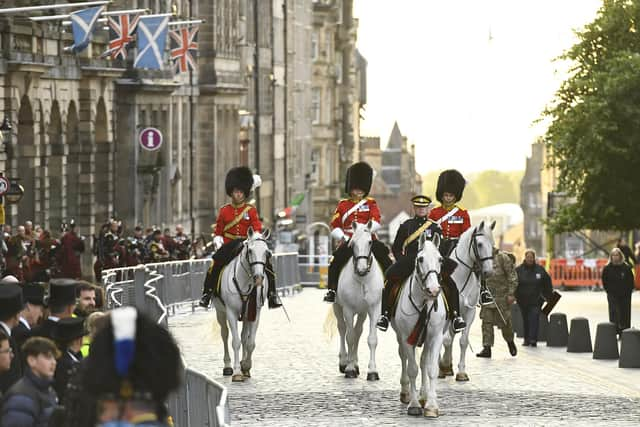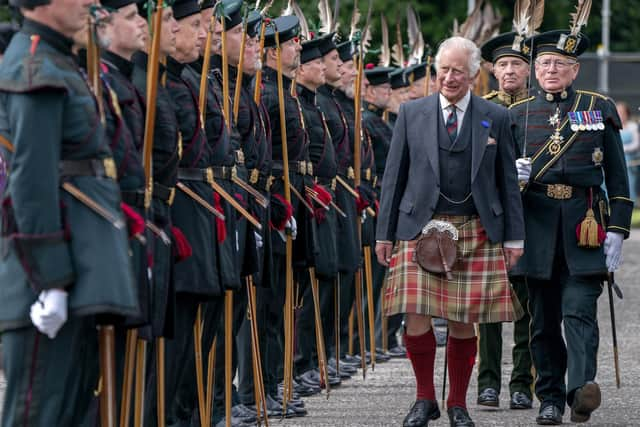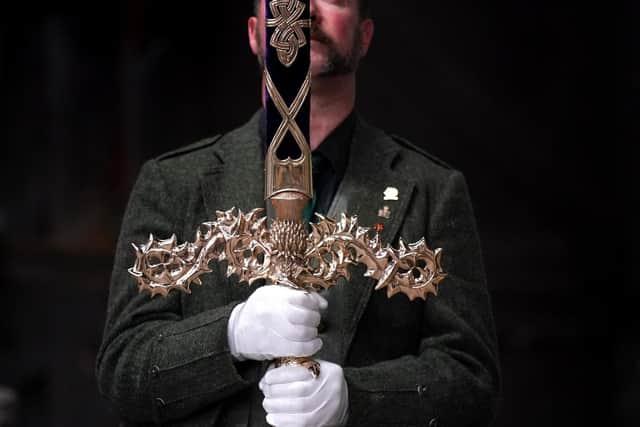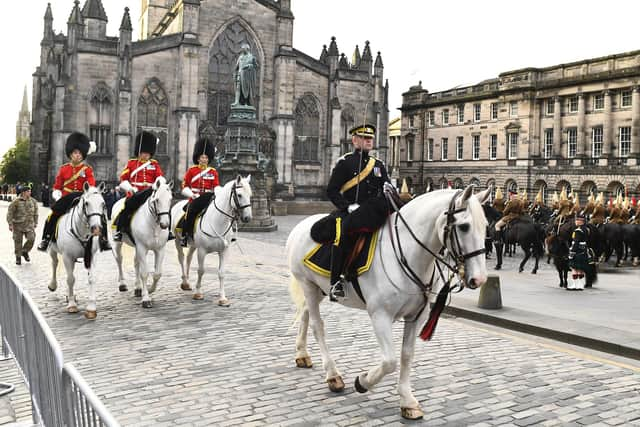King Charles III service: From posties and bus drivers to the ancient and the aristocratic, St Giles' Cathedral moves into place for King's service
Doctors, bus drivers, kiltmakers, fishermen, dentists, posties and teachers will be among those represented during the presentation of the Honours of Scotland to King Charles III and Queen Camilla as “tradition and the new” come together today in an elaborate wrapping of pageantry, ancient title and ceremony.
Dr Joseph Morrow, the Lord Lyon King of Arms, has been the lead ceremonial planner for the National Service of Thanksgiving at St Giles’ Cathedral, which will begin with a People’s Procession from Edinburgh Castle. The procession, which will also include a show of Trades Houses – from The Bonnet Makers & Dyers to The Shoemakers and The Weavers – will then be followed by Scotland's Crown Jewels.
Advertisement
Hide AdAdvertisement
Hide AdThe hereditary crown, which was made for James V in the early 16th century and was used in the coronation of Mary, Queen of Scots, Charles I and Charles II, will be presented to the King by Alexander Douglas-Hamilton, 16th Duke of Hamilton, whose grandfather performed the role at the St Giles’ service for Queen Elizabeth in June 1953.


Escorting the Duke with the crown on Wednesday as it comes into St Giles’ will not be an Earl or a Baron, but Ailsa Russell, the head girl of Clydeview Academy in Gourock, and Lochlan Sweaton, the head boy of Balwearie High School in Kirkcaldy.
Dr Morrow said: “What we have done is bring in some significant modern elements to make sure it is not something that is repeating what happened in 1953, but actually creates something that takes us into the future and establishes this ceremonial as a part of Scottish life.
"I was very keen on several parts to do with modernisation and I was very keen that we had a broad spectrum of the diverse talent of Scotland and that we had people from every aspect of Scottish life participating.
"The purpose for Wednesday for me is to bring together the traditions of monarchy in Scotland with a modern society and and reflect them together for the next generation. It is also about celebrating the new monarchy and welcoming the King. Hospitality is, of course, renowned in Scotland and the creation of that hospitality for our monarch is even more significant as expressed within this ceremony. It is a warm welcome.”


Dr Morrow added: “The only thing I can say is that none of this can be done on your own and that ‘team Scotland’ , which consisted of everybody involved from the military down to volunteers, were absolutely wonderful at pulling together and refining the process to bring this together.”
The Honours of Scotland are the oldest Crown Jewels in the United Kingdom. They were saved from Dunnottar Castle near Stonehaven, where they had been taken for safe keeping as the forces of Oliver Cromwell, who had already destroyed the English regalia, encircled the stronghold.
The jewels were removed by a group of local women in an plot that ended with the treasures being hidden, possibly in a sack of flax, and moved to nearby Kinneff Church. There they remained for nine years. The women moved them on horseback, with it said it was preferable for the honours to be thrown into the sea than allow them to fall into English hands.
Advertisement
Hide AdAdvertisement
Hide AdLater the honours returned to Edinburgh Castle and were locked in a chest following the 1707 Act of Union. They were rediscovered in 1818 by Sir Walter Scott.


At St Giles’ on Wednesday, the Honours of Scotland will include the newly-commissioned Elizabeth sword, which was forged at Powderhall Bronze Foundry in Edinburgh. It will replace for the occasion the now fragile Sword of State that was presented to James IV in 1507 by Pope Julius II, who commissioned Michelangelo to paint the ceiling of the Sistine Chapel.
The Elizabeth Sword will be presented to the King by Dame Katherine Grainger, the Olympic gold medallist rower and Chancellor of the University of Glasgow.
The sceptre, a gift in 1494 from Pope Alexander VI to James IV, as a mark of papal support for Scotland as a 'special daughter' of the Holy See, will be presented to the King by Lady Dorrian, Lord Justice Clerk.
Dr Morrow said: “Katherine Grainger represents excellence in Scotland and university life. Lady Dorrian was picked to reflect the diverse nature of Scotland and the Duke of Hamilton, takes us into that tradition and heritage. There is a link from the old to the new. As well as modernising the ceremony, I think it is important to keep that link to the old.”


As Hereditary Crown Bearer, the 16th Duke of Hamilton, whose family home is Lennoxlove House near Haddington, placed the Crown on Queen Elizabeth’s coffin at the Service of Remembrance at St Giles’ in September 2022.
Of the head boy and head girl who will escort the Duke of Hamilton, Dr Morrow added: “They were chosen as Balwearie is my old secondary school, which I left 50 years ago. Clydeview petitioned for a set of arms for it new tartan to mark its tenth anniversary and I was very impressed with the talent that I found at the school.”
Once the Honours of Scotland have all been placed on the Honours Table, the King and Queen will arrive from the Palace of Holyrood House with the Duke and Duchess of Rothesay. The Stone of Destiny, the most ancient symbol of Scottish monarchy, will also be in place.
Advertisement
Hide AdAdvertisement
Hide AdDr Morrow said the essence of the service – a “celebration of Scottish music and talent” – mirrored that of 1953. Highlights of the programme include Nicola Benedetti and The Honours of Scotland Ensemble performing Farewell to Stromness, composed by Peter Maxwell Davis. Ryan Corbett on accordian will play Loch Katrine’s Lady by Phil Cunningham while Caledonia, composed by Dougie MacLean, will be performed by Robert Lovie, Ryan Corbett and the Honours of Scotland Ensemble.
Comments
Want to join the conversation? Please or to comment on this article.